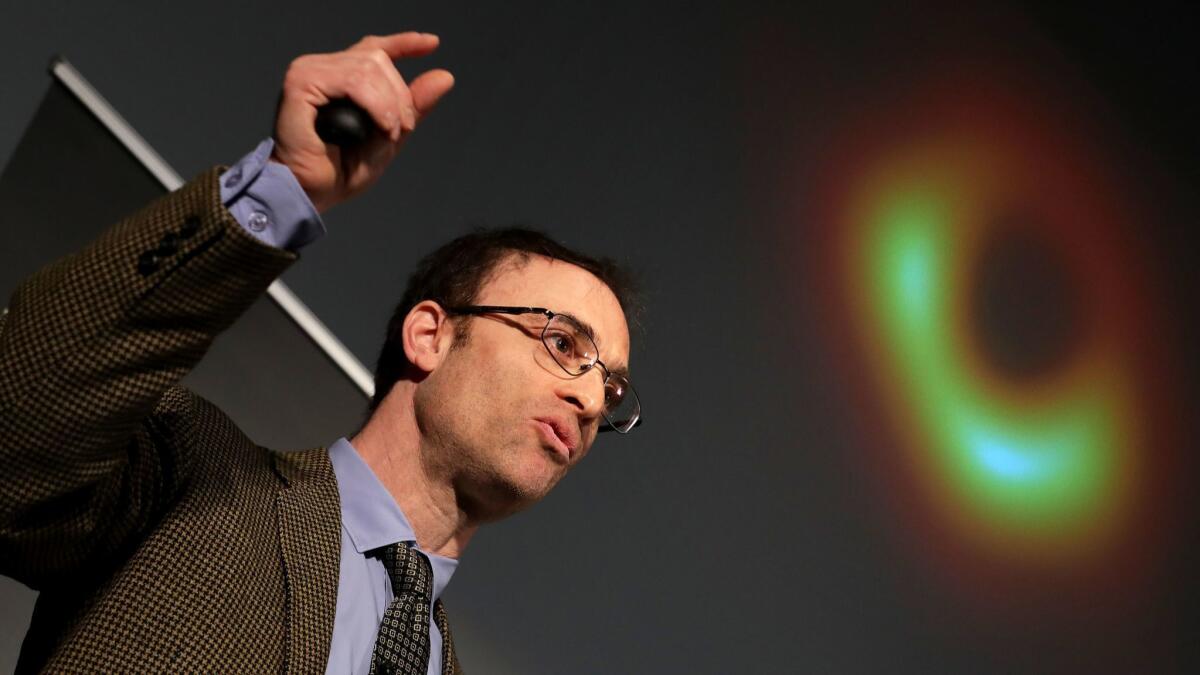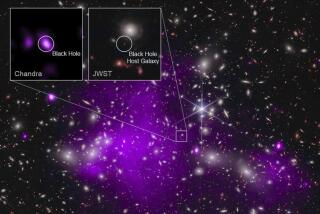Here it is, the first-ever image of a black hole
- Share via
In the swirling heart of a distant galaxy, 55 million light-years from Earth, lies a supermassive black hole with a mass 6.5 billion times greater than that of our sun.
The gravitational pull of this dark beast in the Messier 87 galaxy is so strong that not even light can escape its gaping maw.
Its powerful gravity bends the fabric of space and time around it, and its violent moods determine when and where new stars can form in the galaxy.
Gas and dust spin and churn as they hurtle into its abyss. Matter around it moves so fast that it gets superheated to hundreds of millions of degrees, sending powerful jets of radiation shooting across the cosmos.
And now, scientists have captured an image of the very edge of this object, a region known as the event horizon, beyond which nothing can hope to return.
It is the first picture ever taken of a black hole.
The effort to photograph it required an international team of 200 scientists and a virtual Earth-sized radio telescope to collect the necessary data. Then it took two more years of supercomputer processing and analysis to ensure that no errors were made.
“Making an image of a black hole doesn’t come easily, as many people can tell you,” said Shep Doeleman, an astrophysicist at Harvard University and project director of the global endeavor known as the Event Horizon Telescope. “But we consider ourselves to be explorers. We exposed a part of the universe that had never been seen before.”
The breakthrough image shows a ring of fuzzy light orbiting a dark circular center. The light is from the superheated gas as it is being bent by gravity around the black hole itself, Doeleman said.
“This is the geometry of space and time being laid bare to you,” he said. “You are seeing the gravitational well of the black hole.”

Daniel Stern, a cosmologist who studies black hole formation at NASA’s Jet Propulsion Laboratory in La Cañada Flintridge, said he woke up at 6 a.m. to watch live as Doeleman unveiled the picture at a news conference in Washington, D.C.
“It was phenomenal,” he said. “This will go down in the annals of astronomy as one of the greatest images ever taken.”
The picture, along with six papers describing the black hole, were published Wednesday in the Astrophysical Journal Letters.
Astronomers who study the most extreme environments in space say the picture was worth the wait.
“As an astrophysicist, this is a thrilling day for me,” said France Cordova, director of the National Science Foundation, which helped fund the work. “We have been studying black holes for so long, it is easy to forget that none of us has ever seen one.”
Black holes were first predicted by Albert Einstein’s general theory of relativity, though it was another physicist named Karl Schwarzschild who described them in a paper published in 1916. Einstein himself doubted their existence — their properties seemed too crazy, too extreme — and he thought he must have made a mistake.
Einstein’s theory suggested that a massive object like the Earth would bend the fabric of space-time around it just a little, like placing a golf ball in the middle of a taut bedsheet.
But a black hole has such enormous gravity that it would rip the space-time fabric apart.
In theory, you can make a black hole out of any amount of mass, as long as it is squeezed tightly enough to be sufficiently dense.
“If you took a baseball and crushed it down small enough, eventually it would rip the fabric of space-time too,” said Caltech physicist Fiona Harrison.
Most of the black holes in the universe are stellar black holes. They are created when a star at least 20 times more massive than our sun runs out of fuel. Without a nuclear engine to heat and expand the gases in its interior, the star’s own gravity will cause it to collapse endlessly on itself, growing infinitely smaller and more dense until its gravitational pull is so great that not even light can escape.
But there is another species of black hole that is more rare and more powerful. These supermassive black holes are 1 million to 1 billion times more massive than the sun.
Scientists don’t know how supermassive black holes are formed, but they think they lie in the center of every galaxy in the universe. They also appear to constrain how big a galaxy can grow, and when and where star formation takes place.
The supermassive black hole in the historic picture released Wednesday lies at the center of Messier 87, a huge galaxy home to trillions of stars. M87’s black hole is roughly 24 billion miles across. That’s almost 10 times greater than the distance between the sun and Neptune.
Although the M87 black hole’s event horizon has never been seen before, the Hubble Space Telescope has imaged enormous jets of high-energy particles shooting away from its vicinity at 2 million mph across 5,000 light-years of space.
The black hole is embedded in a bubble of hot gas that only radio waves can penetrate. The resolution of a radio telescope is directly proportional to its size, and in order to see the black hole’s event horizon, scientists needed a telescope with a dish roughly the size of Earth.
Building an instrument that size is not possible, but scientists came up with another solution. By syncing up eight radio telescopes scattered across the planet, they were able to make a virtual dish big enough to resolve the M87 event horizon and see the hot gas swirling around it.
“Imagine taking a hammer, smashing a radio dish, and spreading the fragments all over the Earth,” Doeleman said recently while describing the project at the South by Southwest festival in Austin, Texas. “In reality, we did that by linking up telescopes on different continents and timing the data-taking perfectly.”
That makes it sound easy. It wasn’t.
“A lot had to come together theoretically, computationally, electronically and observationally for this to happen,” said Peter Galison, a science historian at Harvard who was not involved with the project.
None of the eight telescopes used to capture the image were built for this type of observation, so they all had to be refashioned to collect the right type of data. Hundreds of people were mobilized and millions of dollars were spent to ensure the data were collected correctly. New computer-processing strategies also had to be developed to stitch it all together.
In addition to all this, the weather gods had to bestow their blessing. The plan required each telescope to look at the same patch of sky at the same time. That means there had to be clear skies over Hawaii, Spain, Chile, Mexico, Arizona and the South Pole on the same night.
There is only one time of year when good weather might occur at all these locations, and that’s in April.
Seth Fletcher, an author who embedded with the team for five years to write the book “Einstein’s Shadow: A Black Hole, a Band of Astronomers, and the Quest to See the Unseeable,” said there were times he thought the project might fail.
“They were trying to do the first observations in 2015, and they didn’t get that done. They couldn’t do it in 2016 either,” he said. “I think a lot of people were thinking, when is this going to happen?”
Finally, in the first 10 days of April 2017, the team was able to make a successful observation.
Individual telescopes collected so much data that it was quicker to FedEx the information on hard drives to researchers at the MIT Haystack Observatory in Westford, Mass., and the Max Planck Institute for Astronomy in Bonn, Germany, rather than send it over the internet, said University of Arizona astronomer Dimitrios Psaltis, the project scientist for the Event Horizon Telescope.
Ultimately, the team members hope the image will help answer questions about the strange processes that occur at a black hole’s edge. It will also allow them to test Einstein’s theories at one of the most extreme environments in the universe.
The researchers have already determined that the silhouette of the black hole’s event horizon matches the predictions of general relativity, proving Einstein right again.
“I have to admit I was a little stunned that it matched so closely the predictions we had made,” said Avery Broderick, a theoretical astrophysicist at the University of Waterloo in Canada and a member of the Event Horizon Telescope’s science team.
The new black hole image is just the first of many discoveries Doeleman and his colleagues hope to make with the Event Horizon Telescope. The team is still working on resolving another image it took in April 2017 of Sagittarius A*, the smaller supermassive black hole at the center of the Milky Way galaxy.
Andrea Ghez, an astrophysicist at UCLA who has been studying Sagittarius A* for two decades, said she was a little disappointed that the first image wasn’t of our local supermassive black hole. But that feeling didn’t last long.
“I was delighted to see that they saw the ring so clearly,” she said. “There was a lot of concern that they would only see a partial ring.”
In April 2018, the Event Horizon Telescope team made additional observations of both M87’s supermassive black hole and Sagittarius A*. That time around, they added a telescope in Greenland to their array and captured twice as much data as they recorded in 2017.







